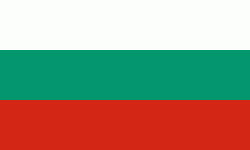Pazardzhik
 |
The history of Pazardzhik can be traced back to the 7th millenium BC, with early civilisations being brought from Asia-Minor. They were agro-pastralists and settled near Maritsa, Pazardzhik and Sinitovo. A clay idol named the Pazardzhik Venus was founded in 1872.
The Drougoubitai tribe settled in the early Middle Ages. Many different researches have all been disputed on the founding of Pazardzhik. One of them was that the city was founded in 1395 by nomads from Saruhan. Another one was three years later in 1398, the city was founded by the migration of Tatars from Actav to Rumelia. The third is about the establishment in 1418, where the Minnet Bey and the Tatars came from from Isquilip, and the fourth thesis and the final one is the city's foundation from the resettled Crimean Tatar people. Rice cultivation intensified in the region, which made the economy of the city grow.
During the Russo-Turkish War (1806–1812), there was a brief siege under Count Nikolay Kamensky. In the mid-19th century, it was an important craft and trade centre. Many institutions were established in this period. Тhe Church of the Dormition was first founded. Vasil Levski appointed the revolutionary committee in Pazardzhik as a second centre in 1872. Following 4 years after that, Georgi Benkovski resumed the activity of the committee. During the Russo-Turkish War (1877–1878), Iosif Gurko wrestled the Ottomans out of the city and during the same period, Ovanes Sovadzhian prevented the annihilation of the city.
The first reported Red Army troops entered Pazardzhik on 23 September 1944. After 9 September 1944, the city grew to an industrial centre, which in 1947 during nationalisation, began consolidation of industrial enterprises. There were demonstrations consisting of about 5,000 protesters, demanding to change to democracy.
The economy of Pazardzhik is now a slowly growing one. GDP per capita is 9,101 BGN in 2012. The average monthy salary was 635 BGN and unemployment was 5.2% in 2015. The economy today is mainly based on agriculture, which also includes animal breeding. Farms are mainly located in the fertile land of the Upper Thracian Plain.
The landmarks of the city are the clock tower, Church of the Dormition, which has a wood-carved iconstasis protected by UNESCO, the History Museum, the old post office, the Drama Theatre and the other museums.
Map - Pazardzhik
Map
Country - Bulgaria
 |
 |
| Flag of Bulgaria | |
One of the earliest societies in the lands of modern-day Bulgaria was the Neolithic Karanovo culture, which dates back to 6,500 BC. In the 6th to 3rd century BC the region was a battleground for ancient Thracians, Persians, Celts and Macedonians; stability came when the Roman Empire conquered the region in AD 45. After the Roman state splintered, tribal invasions in the region resumed. Around the 6th century, these territories were settled by the early Slavs. The Bulgars, led by Asparuh, attacked from the lands of Old Great Bulgaria and permanently invaded the Balkans in the late 7th century. They established the First Bulgarian Empire, victoriously recognised by treaty in 681 AD by the Eastern Roman Empire. It dominated most of the Balkans and significantly influenced Slavic cultures by developing the Cyrillic script. The First Bulgarian Empire lasted until the early 11th century, when Byzantine emperor Basil II conquered and dismantled it. A successful Bulgarian revolt in 1185 established a Second Bulgarian Empire, which reached its apex under Ivan Asen II (1218–1241). After numerous exhausting wars and feudal strife, the empire disintegrated and in 1396 fell under Ottoman rule for nearly five centuries.
Currency / Language
| ISO | Currency | Symbol | Significant figures |
|---|---|---|---|
| BGN | Bulgarian lev | лв | 2 |
| ISO | Language |
|---|---|
| BG | Bulgarian language |
| TR | Turkish language |















